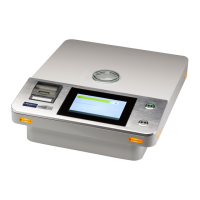Define standards to be available for performing a regression. Each standard
displays as an individual page where the user can set the standard name,
composition and whether or not to include the standard in the regression.
Standards are measured directly from these screens.
View the analytical data of the calibration standards, choose which type of
calibration model is to be used, define the ratio model and power (for ratio
modes). Choose modifications to absorption and enhancement corrections,
additive corrections, and instrument corrections such as blank correction,
overlap corrections, and restandardization.
Choose calibration options
Type in a description of the calibration and/or
matrix
Post-Analysis
Calculations
Define equations for calculated elements, such as
oxides or isotopes. Define fixed values.
Define name, elements, and concentrations
How many times to analyze the sample and
average the results
How many replicate samples to average the results
Export the calibration to a USB stick for use on
another LAB-X unit.
Re-analyze standards for a calibration to adjust for drift
Import a calibration from a USB stick, that was built on another LAB-X unit
5.3.
Restandardization involves measuring the Setting Up Samples (SUSs) that were 5.3.1.
measured as part of the calibration. Once they have been measured they correct for
any change in the position of the calibration line, both in terms of background or
sensitivity change.
If the calibration involved a matrix correction, such as an overlap correction, then the 5.3.2.
SUSs used in the correction are also measured as part of the restandardization
procedure.
Each SUS will have to be measured in turn to restandardize. 5.3.3.
5.4.
A calibration curve must be established before routine analysis can begin. 5.4.1.
A new calibration can be created in one of three ways: 5.4.2.
Defining the measurement conditions, typing in the concentration data for a set of 5.4.2.1.
standards, then analyzing those standards (this section)
Measuring a set of calibration standards using a Hitachi pre-programmed 5.4.2.2.
calibration (see section 5.5 Import Calibration)
Importing a calibration from another LAB-X instrument (see section 5.5 Import 5.4.2.3.
Calibration)
Before a calibration can be derived, a Test Measurement scan should be performed on 5.4.3.
standards similar to the samples expected to be routinely analyzed to ensure that the
correct ‘window’ settings are used. (See Section 5.8 Test Measurement)
The series of standards needs to be similar to the unknown samples is 5.4.3.1.
composition, with a concentration range encompassing or exceeding the expected
concentration range of the unknowns.
Hitachi High-Tech Analytical Science
▶
29

